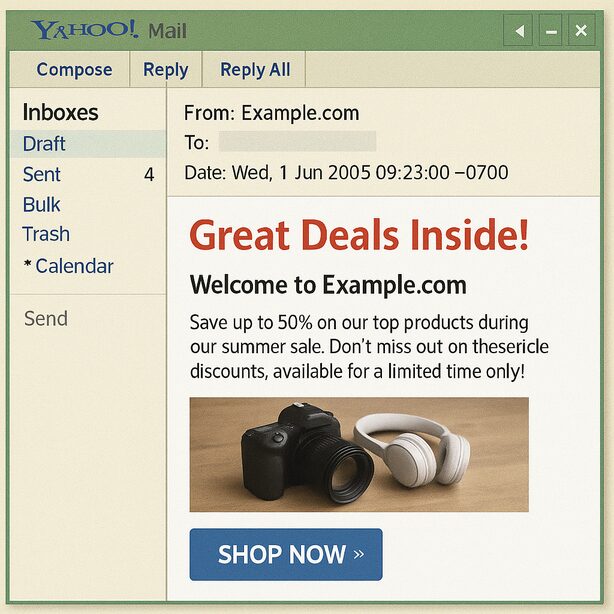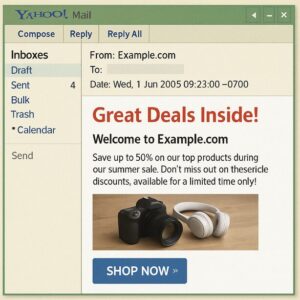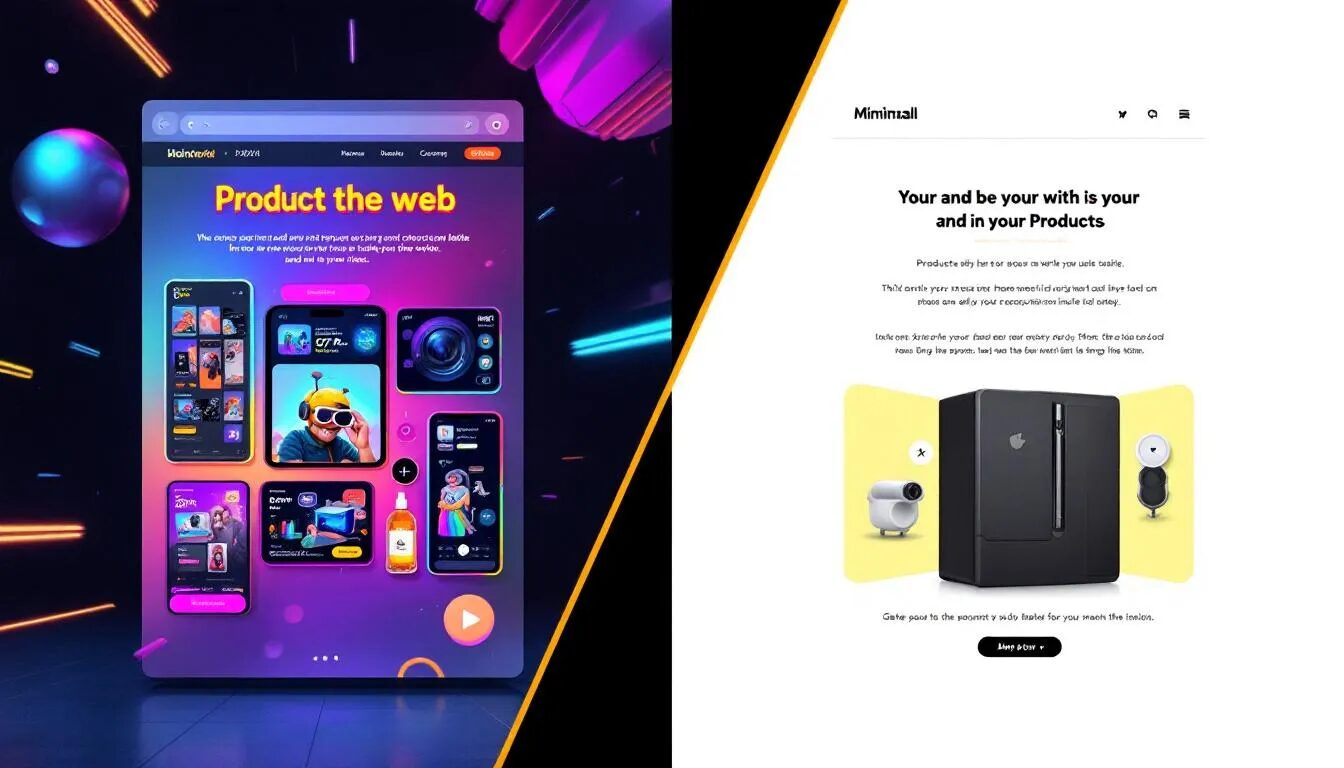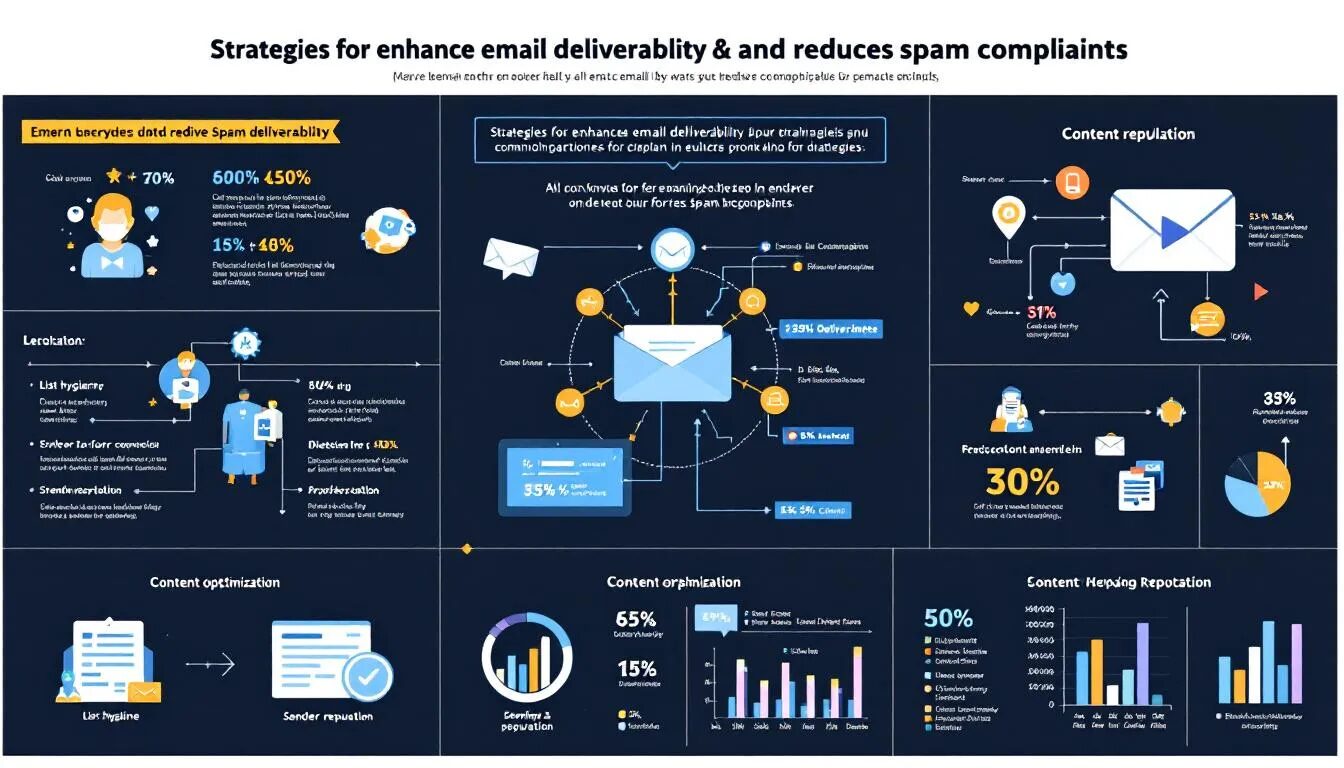
Inbox Nostalgia: What Marketing Emails Looked Like in 2005 vs Today
Want to know how marketing emails have changed from 2005 to now? This article on inbox nostalgia what marketing emails looked like in 2005 vs today reveals the evolution from basic text-heavy formats to today’s personalized, visually rich messages. Dive into how design, content, technology, and user engagement have transformed. We will also discuss the evolution of inboxes and marketing emails from 2005 to today.
Key Takeaways
- Marketing emails in 2005 were text-heavy and simplistic, focusing solely on promotion without personalization or advanced design.
- The evolution of email marketing has been driven by technological advancements, changes in consumer behavior, and regulatory changes, leading to highly personalized and visually rich modern emails.
- Best practices for modern email marketing include crafting engaging subject lines, leveraging data analytics for optimization, and ensuring regulatory compliance to build trust with recipients.
- The benefits of modern email marketing include increased engagement, better targeting, and higher ROI, helping businesses add value for customers and build a stronger brand reputation.
Marketing Emails in 2005

Marketing emails in 2005 were a far cry from the visually appealing and interactive messages we see today. Back then, simplicity was the name of the game. Emails were characterized by:
- Being primarily text-heavy
- Having limited design elements
- Using basic HTML formatting The focus was on delivering straightforward promotional messages without the bells and whistles of modern email marketing.
With the rise of the internet, email quickly became a primary form of communication for both businesses and consumers, as widespread internet access enabled more people to create and use an email account for daily correspondence and marketing.
The design and layout of these emails were basic, emphasizing readability over aesthetics. Marketers relied on simple HTML structures, avoiding complex graphics and multimedia elements. Users typically had to log into their email account using desktop clients or early webmail services to access these messages. This approach ensured that emails were easy to create and manage, but it also meant that they lacked the visual appeal that captivates today’s audiences.
Content and message in 2005 were direct and promotional. Emails featured straightforward language aimed at promoting products or services, with little to no personalization. This lack of targeted messaging reflected the limitations of the technology and tools available at the time. Marketers had to work within the constraints of basic email clients, which lacked sophisticated automation and analytics capabilities.
Design and Layout
The design of marketing emails in 2005 was characterized by simplicity and functionality. Marketers used basic HTML to create straightforward layouts that emphasized readability. There were no advanced graphics or multimedia elements; instead, emails relied on text to convey their messages. This simplicity was partly due to the limitations of the technology available at the time, which didn’t support the rich media elements we see in today’s emails.
Companies focused on ensuring that their emails were easy to read and navigate. The lack of intricate graphics meant that emails loaded quickly and were compatible with the email clients of the time, such as Microsoft Outlook. While this approach ensured that emails reached their intended recipients, it also meant that they lacked the visual appeal and engagement potential of modern marketing emails.
Content and Messaging
In 2005, the content and messaging of marketing emails were quite different from what we see today. Emails typically used direct promotional language, focusing on selling products or services without much personalization. The lack of advanced analytics and segmentation tools meant that marketers had to rely on generic messages that were sent to their entire email list.
For example, a typical 2005 marketing email might simply say, “Buy now and save 20% on our latest product—click here to shop,” with a clear call to action and little customization.
This approach often led to less engagement, as recipients received emails that weren’t tailored to their preferences or behaviors. The absence of personalized content meant that mail could easily be overlooked or even deleted, reducing their effectiveness. Here are some tips to improve engagement.
Despite these limitations, this straightforward approach laid the groundwork for the more sophisticated strategies we see in digital marketing today.
Technology and Tools
The technology and tools available for email marketing in 2005 were basic and limited. Marketers had to work with basic email clients that offered minimal features for automation and analytics. This meant that they couldn’t easily track the performance of their campaigns or personalize their messages based on user behavior.
Some users opted for a paid account to access additional features such as increased storage or fewer ads.
Despite these limitations, businesses still saw the value in email marketing as a communication and advertising tool to communicate. The simplicity of the available tools meant that marketers had to be creative with their strategies, often relying on traditional marketing tactics to engage their audience.
This era of email marketing was marked by a focus on reaching as many people as possible to promote straightforward, promotional messages.
Features of a 2005 Inbox (NEW)
Back in 2005, the typical email inbox was a very different environment from what we experience today. Most users accessed their email accounts through desktop clients like Microsoft Outlook or web-based services such as Hotmail, Yahoo! Mail, or the then-new Gmail. Mobile device access was rare, as smartphones were not yet widespread, so checking your inbox usually meant sitting at a desktop computer.
Organization tools were basic at best. Features like folders and simple filters helped users manage their mail, but advanced sorting, tagging, or smart search options were limited. Spam was a major issue—many inboxes were flooded with unsolicited ads and irrelevant offers, making it challenging for users to spot important messages from businesses or personal contacts. Spam filters existed, but they were far less effective than today’s sophisticated algorithms.
For both personal and business users, the inbox was often cluttered, with little distinction between different types of messages. Free accounts typically came with storage limits, so users had to regularly delete old emails or risk losing access. Paid accounts offered more space and a few extra features, but the overall experience was still quite basic.
Attachments were another pain point. Sending or receiving large files was cumbersome, and many email services imposed strict limits on attachment size. Features like conversation threading, advanced search, or integrated calendars were either rudimentary or nonexistent.
In summary, a 2005 inbox was functional but far from the streamlined, feature-rich platforms we rely on today. Marketers and users alike had to adapt to these limitations, shaping the early days of digital marketing and email communication.
Evolution of Email Marketing
Over the last two decades, email marketing has undergone a significant transformation. What started as a basic communication tool has evolved into a sophisticated marketing strategy that leverages advanced technology and data analytics to deliver highly personalized and targeted campaigns. This evolution has been driven by technological advancements, changes in consumer behavior, and regulatory changes.
Technological advancements have revolutionized email marketing, introducing sophisticated automation tools and advanced analytics that allow marketers to create highly personalized messages based on user behavior. Changes in consumer behavior have also played a crucial role, as consumers now expect personalized and relevant content in their inboxes. Modern email marketing often relies on integrated platforms that combine email tools with other marketing features, providing businesses with a comprehensive solution to manage and optimize their campaigns. Using an all-in-one marketing platform, such as Mailchimp, can further enhance email marketing efforts and support overall brand growth.
Regulatory changes, such as the GDPR and CAN-SPAM Act, have further shaped email marketing practices by emphasizing transparency and user consent. This evolution has transformed email marketing from its simple beginnings into a powerful tool that businesses use to engage with their audience, drive sales, and build brand loyalty.
Understanding these changes helps marketers stay ahead of the curve and implement strategies that resonate with today’s consumers. Having the right knowledge of evolving email marketing strategies is essential for marketers to remain competitive in a rapidly changing landscape.
Technological Advancements
Technological advancements have been a driving force behind the evolution of email marketing. The introduction of sophisticated automation tools has allowed marketers to create personalized messages that are triggered by user behavior. This has made it possible to deliver timely and relevant content to recipients, enhancing engagement and conversion rates.
The introduction of services like Gmail by Google revolutionized email marketing by providing advanced features and seamless integration with other productivity tools, making it easier for users to manage communications and collaborate efficiently.
Advanced analytics tools have played a crucial role by enabling marketers to:
- Track engagement metrics in real-time
- Make informed decisions based on data
- Optimize their email campaigns for better performance
- Track detailed metrics such as click-to-open rates and conversion rates
These capabilities provide marketers with deeper insights into their audience’s behavior, allowing for more effective strategies.
Changes in Consumer Behavior
Consumer behavior has changed dramatically over the past two decades, influencing how marketers approach email marketing. Today, consumers expect personalized and relevant content in their inboxes. This shift has prompted marketers to adopt strategies that focus on individual preferences and purchase history, ensuring that emails resonate with each recipient.
Modern email marketing strategies are designed not only to retain existing clients but also to attract new customers through targeted and personalized content.
Email marketing metrics have also evolved, shifting from basic open and click-through rates to deeper engagement analysis. Marketers now focus on metrics that measure customer lifetime value and engagement levels, providing a more comprehensive understanding of their audience. This shift has allowed businesses to identify high-intent leads and tailor their follow-up strategies accordingly.
Regulatory Changes
Regulatory changes have had a significant impact on email marketing practices. Legislation such as the GDPR and the CAN-SPAM Act has mandated stricter consent requirements, ensuring that consumers have more control over their data. These regulations have reshaped how companies manage customer data and approach email marketing.
The GDPR, implemented in 2018, requires explicit consent for data collection, while the CAN-SPAM Act mandates clear opt-out options in every email. These regulations have emphasized transparency and consumer consent, forcing marketers to enhance their practices. Adhering to these guidelines is crucial for maintaining user trust and avoiding legal penalties.
Types of Email Marketing (NEW)
Email marketing has always been a versatile tool for businesses, but the types of campaigns and strategies have evolved significantly over time. Understanding the different types of email marketing can help companies create targeted campaigns that connect with both new and loyal customers, drive traffic to their site, and boost sales.
1. Newsletters: Newsletters are a staple of digital marketing, providing regular updates, company news, and valuable content to subscribers. They help businesses stay top-of-mind with their audience and build long-term relationships. Newsletters often feature articles or blog posts to engage readers and promote new content, highlighting the important role of blogs in email marketing strategies.
2. Promotional Emails: These emails focus on advertising new products, special offers, or limited-time discounts. They’re designed to drive immediate action, such as making a purchase or signing up for a free account or service.
3. Transactional Emails: Sent in response to a user’s action—like a purchase confirmation, shipping update, or password reset—transactional emails are crucial for customer communication and building trust.
4. Re-engagement Campaigns: When customers become inactive, re-engagement emails aim to win them back with special offers, reminders, or personalized content. These campaigns help companies maintain a healthy, engaged email list.
5. Event Invitations and Announcements: Businesses use these emails to invite customers to webinars, product launches, or company events, helping to drive attendance and promote new offerings.
6. Welcome Series: A sequence of emails sent to new subscribers or customers, introducing them to the brand, its values, and key offerings. This type of campaign is essential for onboarding and nurturing new relationships.
Each type of email marketing campaign serves a unique purpose within a broader marketing strategy. By leveraging the right mix, marketing managers can engage different audience segments, promote their brand, and achieve specific business goals.
Modern Marketing Emails

In today’s digital marketing landscape, marketing emails have evolved into highly personalized and visually rich messages that engage and convert. The transformation from the simple, text-heavy emails of 2005 to the dynamic, interactive campaigns of today is a testament to the advancements in technology and the changing expectations of consumers.
Modern marketing emails combine visually appealing elements with strategic content to enhance engagement and conversion rates. They are optimized for various devices, ensuring a consistent experience whether viewed on a desktop or a mobile device. Today, marketing emails are designed not only to engage but also to sell products and services more effectively through targeted messaging. This evolution has made email marketing a powerful tool for businesses to connect with their audience and drive sales.
The key characteristics of contemporary marketing emails include sophisticated design and layout, personalized and segmented content, and interactive elements that engage users. These elements work together to create a compelling user experience that drives engagement and builds brand loyalty.
Design and Layout Today
The rise of mobile device usage has significantly impacted how consumers access emails, prompting marketers to optimize their content for mobile viewing. Modern email designs frequently utilize:
- Rich HTML and CSS to create visually striking layouts that resemble mini landing pages
- High-quality images
- Videos
- Other rich media elements to enhance engagement and user experience.
Responsive design has become a standard practice, ensuring that emails look great on any device. This shift from the simple text formats of 2005 to complex designs featuring multimedia elements has dramatically improved the visual appeal of marketing emails. Marketers now have the tools to create visually engaging emails that capture the recipient’s attention and drive action.
Personalization and Segmentation
Personalization has become a cornerstone of modern email marketing. Incorporating personalized content in emails can significantly enhance engagement and response rates. Personalized emails can achieve up to six times higher transaction rates compared to generic ones. This level of personalization is made possible by advancements in email marketing technology, which allows for automation and segmentation.
Effective email marketing relies on understanding the target audience and tailoring content to their preferences. Segmentation of email lists into various demographics or behaviors can significantly boost open and click-through rates. By sending messages that resonate with specific audience segments, marketers can increase engagement and build stronger relationships with their customers.
Interactive Elements
Incorporating interactive elements like surveys and polls in emails enhances user engagement significantly. These features not only make the emails more engaging but also provide valuable feedback directly from recipients. Interactive content, such as AMP (Accelerated Mobile Pages), aims to create more dynamic and engaging experiences for users, although support varies across email clients.
The format and complexity of marketing emails have significantly advanced, transitioning from simple text layouts to visually rich, interactive experiences that help marketers and the marketing manager to organize and engage their audience more effectively and drive higher response rates.
By incorporating interactive features, businesses can create a more engaging user experience that fosters deeper connections with their audience and service company.
Email Marketing Trends (NEW)
Email marketing has come a long way since 2005, evolving from a basic communication tool into a crucial part of any digital marketing strategy. Today’s marketing managers and business owners must stay on top of the latest trends to create campaigns that connect with their audience, drive traffic, and build loyal customers. Let’s explore the major shifts, emerging technologies, and future predictions shaping the world of email marketing.
Major Shifts from 2005 to Today
The landscape of email marketing has experienced dramatic changes over the past two decades. One of the most significant shifts is the move toward personalization. Marketers now use customer data and analytics to create targeted campaigns that speak directly to individual preferences and behaviors, making each message feel more personal and relevant.
Another major change is the rise of mobile devices. With more customers checking their inbox on phones and tablets, marketers have had to develop mobile-friendly email templates and strategies to ensure their campaigns look great and function smoothly on any device. This shift has made it crucial for companies to optimize every form of communication for mobile audiences.
Consent and privacy have also become central to email marketing. Regulations like GDPR and CCPA require marketers to obtain explicit consent before sending emails and to protect personal data. This focus on privacy has changed how companies collect, store, and use customer information, making transparency and trust more important than ever.
These shifts have transformed email marketing from a one-size-fits-all approach to a data-driven, customer-centric strategy that delivers real value to both businesses and their audiences.
Emerging Technologies and Tactics
The latest wave of digital marketing innovation is being driven by emerging technologies like artificial intelligence (AI) and machine learning (ML). These tools help marketers automate repetitive tasks, analyze customer preferences, and create highly personalized offers that boost engagement and sales. For example, AI-powered platforms can recommend products based on a customer’s past purchases or browsing behavior, making each campaign more relevant and effective.
Interactive content is another trend gaining momentum. Marketers are now incorporating quizzes, polls, and gamified elements into their emails to engage audiences and encourage participation. These tactics not only make emails more fun but also provide valuable data about customer interests and preferences.
Additionally, marketers are expanding their reach by integrating email campaigns with social media and influencer marketing. By connecting email with other digital channels, companies can build brand awareness, attract new customers, and create a seamless experience across platforms.
These emerging tactics and technologies are helping marketers create more dynamic, engaging campaigns that stand out in a crowded inbox and deliver measurable results for their business.
Predictions for the Future
Looking ahead, email marketing is poised for even more innovation. Automation and AI will continue to streamline campaign management, allowing marketing managers to focus on strategy and creative content. As these technologies become more advanced, marketers will be able to deliver even more personalized experiences, building stronger relationships with loyal customers and attracting new ones.
Customer experience will take center stage, with companies prioritizing relevant, timely content that adds real value for their audience. Marketers will need to develop strategies that not only drive traffic and sales but also foster long-term loyalty and trust.
The rise of voice-activated devices and virtual assistants is set to open new opportunities for email marketing. In the near future, customers may interact with their inbox using voice commands, prompting marketers to adapt their campaigns for this new form of communication.
To succeed in this evolving landscape, marketers must stay informed, embrace new technologies, and continually refine their strategies. By doing so, they can create effective email marketing campaigns that connect with their audience, drive business growth, and keep their company ahead of the competition.
In the next section, we’ll dive into how to structure your email marketing campaigns for maximum impact, with practical tips and best practices for marketers at every level. Whether you’re looking to attract new customers, promote a new product, or build a loyal audience, understanding these trends is crucial for success in today’s digital world.
Comparing 2005 vs Today
The comparison between marketing emails in 2005 and today highlights the dramatic evolution in design, content, and technology:
- Marketing emails in 2005 were predominantly text-heavy with basic designs.
- Today’s emails are visually rich and highly personalized.
- There has been a shift from simple HTML formatting to advanced layouts and rich media elements.
- These changes reflect advancements in technology and changing consumer expectations.
Engagement strategies have also evolved, moving from generic outreach in 2005 to personalized content and interactive elements that enhance user experience. Performance metrics have come a long way, from basic open and click rates to comprehensive analytics that provide deeper insights into different types of campaign performance, offering valuable data for developing optimization ads offerings.
These changes have transformed email marketing into a powerful tool for businesses to engage with their audience and drive sales. By understanding the key differences between marketing emails in 2005 and today, marketers can gain valuable insights into how to improve their current strategies and stay ahead of the competition. The evolution of email marketing is a testament to the power of technology and the importance of adapting to changing consumer behaviors.
Additionally, the evolution of email marketing has enabled businesses to differentiate themselves from competitors through innovative design and personalized content.
Visual Appeal
Visual appeal is a critical factor in the effectiveness of marketing emails. In 2005, emails utilized basic graphics with minimal design sophistication, leading to less engaging visuals. Modern marketing emails, on the other hand, utilize high-quality images and sophisticated design tools to create visually appealing messages that capture the recipient’s attention.
The design sophistication of marketing emails has greatly increased, with modern emails utilizing advanced layouts, animations, and responsive design. This evolution from basic graphics to complex, visually rich designs has significantly enhanced the visual appeal and effectiveness of marketing emails.
Creating visually engaging emails allows marketers to connect with their audience more effectively and drive traffic higher engagement rates.
Engagement Strategies
Engagement strategies in email marketing have undergone a significant transformation. In 2005, marketers relied on straightforward promotional messages sent to broad audiences. Today, personalization is key, with marketers leveraging customer data to tailor content and offers to individual recipients. This shift has led to more effective campaigns that resonate with specific audience segments.
Modern email campaigns often include interactive elements such as polls and surveys to engage users actively. Mapping the customer journey allows marketers to send timely and relevant emails at various stages of the purchase process. This approach ensures that emails are not only engaging but also provide value to the recipients, fostering stronger relationships and driving higher conversion rates.
Advanced engagement strategies and automation tools enable marketers to doe meer by reaching larger audiences and achieving better results with less effort.
Performance Metrics
The performance metrics used to evaluate email marketing campaigns have evolved significantly. In 2005, marketers primarily tracked basic open and click-through rates. Today, advanced analytics enable marketers to track a wide range of metrics, including conversions and customer lifetime value. This comprehensive approach provides deeper insights into campaign performance and helps marketers optimize their strategies.
Regularly analyzing open and click-through rates helps marketers refine their email strategies and content relevance. By understanding what resonates with their audience, marketers can make data-driven decisions that enhance engagement and drive better results. The evolution of performance metrics has empowered marketers to create more effective and targeted email campaigns.
Common Email Marketing Mistakes (NEW)
Even the most experienced marketers can fall into common traps when developing email marketing campaigns. Avoiding these mistakes is crucial for maximizing engagement, building loyal customers, and ensuring your digital marketing efforts deliver real value.
1. Neglecting Segmentation:Sending the same message to your entire email list is a missed opportunity. Without segmenting your audience based on preferences, behaviors, or demographics, your emails may feel irrelevant and end up deleted or marked as spam.
2. Overloading Recipients:Bombarding customers with too many emails can lead to fatigue and increased unsubscribe rates. It’s important to respect your audience’s preferences and find the right frequency for your campaigns.
3. Ignoring Mobile Optimization:With the majority of users now accessing their inbox on a mobile device, failing to optimize your emails for smaller screens can result in poor user experience and lost sales opportunities.
4. Weak Subject Lines:A bland or misleading subject line can doom your email before it’s even opened. Crafting compelling, concise subject lines is essential for grabbing attention and driving open rates.
5. Lack of Clear Call-to-Action (CTA):If your email doesn’t clearly tell the recipient what to do next—whether it’s to sign up, buy, or learn more—you’re missing a key opportunity to drive traffic and conversions.
6. Not Testing or Analyzing Results:Skipping A/B testing or failing to review analytics means you’re missing out on valuable data that could help refine your strategy and improve future campaigns.
7. Non-Compliance with Regulations:Ignoring laws like GDPR or the CAN-SPAM Act can damage your brand’s reputation and result in hefty fines. Always include clear unsubscribe options and respect user preferences.
By steering clear of these common mistakes and following best practices, marketers can create more effective campaigns that connect with their audience, promote their brand, and drive business growth.
Best Practices for Modern Email Marketing
Effective email marketing is crucial for maximizing customer engagement and driving revenue. With a return of $42 for every $1 spent, it’s clear that email marketing can be highly effective when done right. By implementing best practices, marketers can enhance their campaigns and achieve better results.
Reviewing real-world examples of successful email marketing campaigns can help marketers understand and implement best practices.
Key aspects of effective email marketing include:
- Crafting compelling subject lines to capture the recipient’s attention and improve open rates.
- Leveraging data and analytics to optimize strategies and tailor content to the audience’s preferences.
- Ensuring compliance with email marketing regulations to maintain trust and avoid legal penalties.
Following these best practices helps marketers create engaging and effective email campaigns that resonate with their audience and drive business growth. Let’s delve into the specific best practices for crafting compelling subject lines, leveraging data and analytics, and ensuring compliance.
Crafting Compelling Subject Lines
Subject lines play a crucial role in the success of email marketing campaigns. It’s recommended to keep subject lines concise, aiming for no more than 60 characters to ensure readability on mobile devices. Using action-oriented language in subject lines can motivate recipients to open emails, significantly enhancing engagement and open rates.
Engaging subject lines are essential for capturing the recipient’s attention and encouraging them to read the email. Implementing concise and action-oriented subject lines helps marketers improve their email engagement and drive better results. This simple yet effective strategy can make a significant difference in the success of email campaigns, especially for those who are interested in maximizing their outreach.
Leveraging Data and Analytics
Leveraging data and analytics is crucial for optimizing email marketing strategies. Key aspects include:
- Regular A/B testing of email components to determine which strategies yield the best engagement.
- Using a data-driven approach to refine content and delivery methods.
- Ensuring that emails resonate with the audience and drive better results.
Data-driven strategies enable marketers to make informed decisions and tailor their content to their audience’s preferences. Analyzing engagement metrics helps marketers identify trends and optimize future email campaigns. This approach not only enhances engagement but also improves the overall effectiveness of email marketing.
Ensuring Compliance
Ensuring compliance with email marketing regulations is crucial for maintaining trust and avoiding legal penalties. Using personal sender names instead of ‘no-reply’ addresses increases compliance and improves open rates. This practice enhances customer engagement and builds trust with the audience for personal use.
Compliance with regulations such as GDPR and the CAN-SPAM Act is essential for maintaining transparency and consumer consent. Implementing best practices related to sender identity ensures compliance and fosters stronger relationships with the audience.
This approach not only protects businesses from legal issues but also enhances the effectiveness of their email marketing campaigns.
Summary
The evolution of email marketing from 2005 to today has been remarkable. Marketing emails have transformed from simple, text-heavy messages to highly personalized and visually rich campaigns that engage and convert. Technological advancements, changes in consumer behavior, and regulatory changes have all played a crucial role in shaping modern email marketing practices. One of the key uses of modern email marketing is to announce and promote a new product to targeted audiences.
By understanding the key differences between marketing emails in 2005 and today, marketers can gain valuable insights into how to improve their current strategies. Implementing best practices such as crafting compelling subject lines, leveraging data and analytics, and ensuring compliance can enhance the effectiveness of email marketing campaigns and drive business growth. The journey of email marketing is a testament to the power of technology and the importance of adapting to changing consumer behaviors.
Frequently Asked Questions
How have marketing emails evolved since 2005?
Marketing emails have significantly transformed from basic, text-only formats to dynamic, visually appealing campaigns that leverage advanced analytics and personalization to engage recipients effectively. This evolution emphasizes the importance of tailoring content to individual preferences for improved engagement.
What are the key differences in email design between 2005 and today?
Email design has evolved from the simple, text-heavy formats of 2005 to today’s visually rich, responsive layouts that utilize advanced design techniques for enhanced user engagement. This shift reflects a greater emphasis on aesthetics and functionality in modern communication.
How has consumer behavior influenced email marketing strategies?
Consumer behavior has significantly influenced email marketing strategies by driving marketers to prioritize personalized and relevant content that aligns with individual preferences and behaviors. This shift ensures higher engagement and customer satisfaction.
What regulatory changes have impacted email marketing?
Regulatory changes such as GDPR and the CAN-SPAM Act have significantly tightened consent requirements and enhanced the need for transparency in email marketing. Businesses must adapt their strategies to comply with these regulations.
What are some best practices for modern email marketing?
To succeed in modern email marketing, focus on creating compelling subject lines, utilizing data and analytics for insights, and ensuring compliance with relevant regulations. These practices will enhance your engagement and strategy effectiveness.
Want More Tips?
Looking for Check out our latest guides and resources to elevate your marketing game
© 2025, Vertical Response. All rights reserved.



